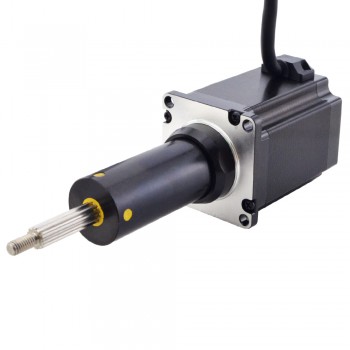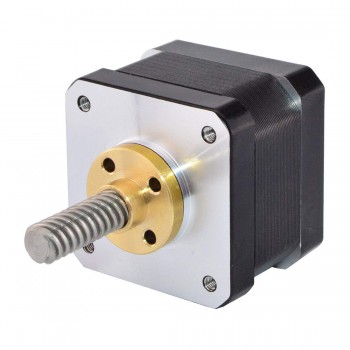Points to note in the design of linear stepper motors
2025/03/04 17:06
瀏覽4
迴響0
推薦0
引用0
1.Definition of linear stepper motor
A linear stepper motor is a motor that converts an electrical pulse signal into a corresponding linear displacement. It controls the rotation of the rotor through the input electrical pulse signal. For each input pulse signal, the rotor moves forward one step. The output linear displacement is proportional to the number of input pulses, and the speed is proportional to the pulse frequency. The linear stepper motor converts rotary motion into linear motion inside the motor, and can directly perform linear motion or linear reciprocating motion.
2.The operating principle of linear stepper motor
1.The principle of selecting a suitable motion speed: The motion speed of a linear screw stepper motor is related to the pole pitch, and the range of pole pitch selection determines the range of motion speed selection. The size of the pole pitch will determine the utilization rate of the low slot. The lower limit of the pole pitch is usually 3cm, but there is no upper limit. When the output power of the motor is constant, the longitudinal length of the primary iron core is limited; at the same time, in order to reduce the longitudinal edge effect, the number of poles of the motor cannot be too small, so the pole pitch cannot be too large, so that its motion speed can be guaranteed.
2.The principle of having a suitable thrust: Most linear stepper motor manufacturers produce motors that are suitable for pushing light loads, because unlike rotary motors, they cannot change thrust at will. To get a relatively large thrust, you can only rely on increasing the size of the motor. Therefore, when the size remains unchanged, you must choose to use a linear stepper motor only under appropriate circumstances, so that it can play its efficient role.
3.The principle of having a suitable reciprocating frequency: In industrial applications, linear motors are reciprocating, and the higher the reciprocating frequency, the higher the labor productivity. This means that the motor must complete the stroke in a shorter time, and within a stroke it must go through the process of acceleration and deceleration, that is, it must start once and brake once. This requires a relatively large acceleration. The greater the thrust corresponding to the acceleration, the greater the reciprocating frequency range must be kept so that it can be carried out in a benign cycle.
3.Points to note in the design of linear stepper motors
1.Application and speed selection: Linear stepper motors should be used preferentially in low-speed applications. The recommended speed per minute should not exceed 1000 revolutions, and the optimal speed range is between 150-450RPM. By using a reduction device, the motor can be kept working within this speed range to improve work efficiency and reduce noise.
2.Avoid using the full-step state: The full-step state may cause increased vibration and affect the use effect. Therefore, the full-step state should be avoided, especially in applications where vibration and noise need to be reduced.
3.Voltage and current control: Choosing the right drive voltage is crucial to the performance of the linear stepper motor. It is generally recommended that 42 stepper motors use DC 12V-24V, while 57 stepper motors use DC 24-36V. In addition, current control is also key. It is necessary to avoid the motor working in the vibration area. If necessary, the voltage, current or damping can be adjusted.
4.Load and starting method: For applications with large moment of inertia or heavy load, the motor should not be started directly at the working speed, but should be gradually increased in frequency and speed. This can keep the motor from losing step, reduce noise and improve positioning accuracy.
5.Solutions for high-precision requirements: If high-precision motion control is required, it can be solved by mechanical deceleration, increasing motor speed or using a drive with a high number of subdivisions. In addition, although 5-phase motors can provide higher precision, they are more expensive and there are fewer manufacturers. Cost and performance requirements need to be considered comprehensively.
6.Application of intelligent tuning technology: In order to achieve smoother motion control, reduce noise and improve positioning accuracy, intelligent tuning technology can be used. This technology automatically optimizes the decay pattern cycle by cycle, maintaining current regulation, so that the motor maintains a smooth and quiet operation.

4.Forecasted development trend of linear stepper motors
1.Miniaturization: Linear stepper motors will continue to develop in the direction of miniaturization to further simplify the overall structure and reduce the space they occupy, which will help improve the portability and efficiency of the equipment.
2.Shape change: From round motors to square motors. This change is intended to meet the motor usage needs of different machines and achieve a wider range of applications.
3.Integrated design: Linear stepper motors will develop in integrated design, which means that the design of the motor will not be limited to a single performance improvement, but will be optimized as a whole, and may even be integrated with the mechanical design to improve overall performance and efficiency.
4.Phase development: Development towards five-phase and three-phase motors. This trend is to meet the high-performance requirements of machinery for motors, and to improve the control accuracy and operation stability of the motor by increasing the number of phases.
自訂分類:不分類
上一則: Design features and maintenance methods of five-phase stepper motors下一則: Unique advantages and applications of bipolar stepper motors
你可能會有興趣的文章:
限會員,要發表迴響,請先登入



